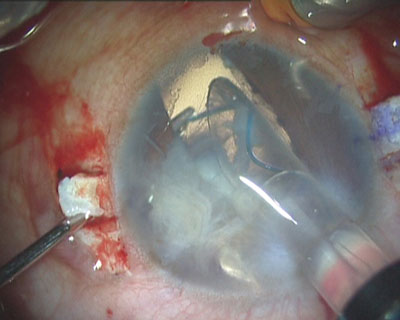Artificial posterior capsule can be created in some cases of posterior capsular rupture
The first glued posterior chamber IOL implantation in an eye with a deficient capsule was done on Dec. 14, 2007. In 2011, we began using the IOL scaffold technique to prevent nuclear fragments from falling into the vitreous cavity. We then wanted to combine the glued IOL technique with the IOL scaffold technique in certain cases, thus creating an artificial posterior capsule in cases of posterior capsular rupture.
Concept and indications
In the IOL scaffold technique, we implant a three-piece foldable IOL above the iris or over the anterior capsule in cases of posterior capsular rupture. This prevents the nuclear pieces from descending into the vitreous because the IOL acts as a scaffold or temporary platform. Once the nucleus is emulsified, the same IOL can then be placed into the sulcus or glued to the sclera, depending on the availability of the anterior capsule.
The problem comes in cases in which iris support is not sufficient, and with that, there is no anterior capsular support for the IOL scaffold technique. In such cases, we cannot implant the IOL to support the nuclear pieces because then the IOL may sink. This can happen in cases such as an iris coloboma in which a posterior capsular rupture has occurred and there is no capsular support at all. Alternatively, it can occur in cases such as a floppy iris in which the iris is not taut enough to support the IOL or in cases in which the pupil is very dilated and not constricting due to trauma.

Figure 1. Iris coloboma with a mature cataract.

Figure 2. Phaco in mature cataract with iris coloboma. Note the posterior capsular rupture. Nuclear pieces are brought to the anterior chamber.
Images: Agarwal A
Surgical technique
If there is a posterior capsular rupture, one should stop phacoemulsification. The remaining nuclear pieces are brought to the anterior chamber. One should now fix an infusion cannula and create scleral flaps to prepare for glued IOL surgery. A 20-gauge needle then creates a sclerotomy 1 mm behind the limbus under the scleral flaps. A 23-gauge vitrectomy system is passed through the sclerotomy to perform vitrectomy so that there is no traction in the vitreous. Vitrectomy is an essential step in the surgery because one can otherwise end up with a retinal detachment postoperatively.

Figure 3. The eye is prepared for glued IOL surgery. Scleral flaps are created. The infusion cannula is through a trocar cannula. After vitrectomy, a three-piece foldable IOL implantation is done. Note the cartridge in the anterior chamber. Also note the haptic is slightly out of the cartridge so that it is easy for the glued IOL forceps to grasp the tip of the haptic.
The three-piece foldable IOL is loaded onto the injector, and the cartridge is passed into the anterior chamber. The haptic tip should be slightly out of the cartridge so that it is easy to grasp the haptic with the glued IOL forceps. The haptic tip is grasped with the glued IOL forceps, and while the IOL is unfolded, the haptic tip is still caught. There is no chance of the IOL falling because the haptic is caught with the forceps and the trailing haptic is still outside the clear corneal incision. Using the handshake technique, the trailing haptic is externalized. If the nuclear pieces are occupying a lot of space in the anterior chamber, this maneuver is sometimes difficult. One should use viscoelastic to dislodge the pieces to the side to gain visualization.
A 26-gauge needle is used to create the Scharioth pocket, and the haptics are tucked into the intrascleral pocket. Phacoemulsification of the nuclear pieces is performed. Thus, an artificial posterior capsule has been created using the combination of the glued IOL technique and the IOL scaffold technique. This prevents the nuclear fragments from falling into the vitreous cavity. Now, one can emulsify the nuclear pieces safely without fear of a nucleus drop. Finally, air is injected into the anterior chamber, and fibrin glue is used to seal the haptics in the sclera.

Figure 4. Both haptics are externalized and tucked inside the Scharioth pocket. Phaco of the nuclear pieces is done. An artificial posterior capsule is created by the IOL. Note the IOL scaffold and the glued IOL procedures combined prevent the nucleus from falling down.

Figure 5. Fibrin glue application seals the haptics to the scleral flap.
The biggest problem is if the nuclear pieces are too big, visualization of the haptic is difficult. Another issue is to avoid endothelial damage by using viscoelastics.
Conclusion
By combining the glued IOL technique and the IOL scaffold technique, one can create an artificial posterior capsule in certain select cases of capsular deficiency in which the iris is also deficient or the pupil is too large to support an IOL.
For more information:
- Amar Agarwal, MS, FRCS, FRCOphth, is director of Dr. Agarwal’s Eye Hospital and Eye Research Centre. Agarwal is the author of several books published by SLACK Incorporated, publisher of Ocular Surgery News, including Phaco Nightmares: Conquering Cataract Catastrophes, Bimanual Phaco: Mastering the Phakonit/MICS Technique, Dry Eye: A Practical Guide to Ocular Surface Disorders and Stem Cell Surgery and Presbyopia: A Surgical Textbook. He can be reached at 19 Cathedral Road, Chennai 600 086, India; fax: 91-44-28115871; email: dragarwal@vsnl.com; website: www.dragarwal.com.
- Disclosure: No products or companies are mentioned that would require financial disclosure.
